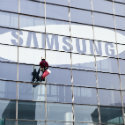Inside Samsung's 5G Factory for AT&T
Top Samsung and AT&T executives lay out the details of their efforts to showcase 5G technology in a factory setting.

Among the businesses with the most to gain from 5G are manufacturing industries that require very high levels of precision in both their processes and their final products. This perfectly describes the semiconductor industry, where changes that are imperceptible to the human eye can have a huge impact on quality.
"Semiconductor facilities are inherently complex and automated," said Derek Johnston, head of marketing at Samsung Networks. He described the company's Austin, Texas, factory as "one of the most advanced fabs in the world."
This complexity makes the chip fab a good candidate for 5G-enabled manufacturing. After AT&T tapped Samsung as one of its 5G radio equipment vendors, the two companies decided to use Samsung's Austin facility as the site of a 5G testbed, which they call the 5G Innovation Zone. It's a private 5G network that uses millimeter-wave (mmWave) spectrum, and also leverages LTE and WiFi. Additionally, the network uses multi-access edge computing, meaning that on-premises servers are connected to the 5G network.
(Source: AT&T)
Mo Katibeh, EVP and CMO of AT&T Business, said the combination of 5G and multi-access edge computing enables the network to react in less than 10 milliseconds, or roughly as quickly as a human can think.
Samsung is using the network to leverage its best people to train new employees and direct workflow by using extended reality. "You can now have your best trainer in the country lead your new employees on interactive training experiences," Katibeh explained. "In manufacturing, turnover is in the high teens. So up to one-fifth of the workforce can be brand new every year." Samsung is using its 5G network to bring new workers up to speed faster, and Katibeh thinks other industries with high turnover, like retail, could also use 5G for remote mobile training.
5G enables training to take place where the actual work happens. Trainees can move around a factory floor without losing their high speed video connection to the instructor. Once they start to do actual work, they can use those same low-latency connections to get real-time help if they need it.
"You hit a button and then you are connected with a remote expert who sees what you see because you have a camera in your headset," said Katibeh. "They guide you and tell you what you need to do."
The workers can wear Microsoft HoloLens headsets that connect to the 5G network. Edge computing and augmented reality enable workers to see instructions on how to install and repair factory equipment. The worker can look at the headset display to see the steps, and the application uses the camera's video feed to monitor the work and display the correct instructional information.
Samsung is trialing other use cases for its 5G network, including a 5G connection to Austin's first responder network in case of emergencies, and sensors on factory equipment to monitor variables like temperature and humidity.
"The key thing with 5G, where I'm excited about it, is we're going to be able to deploy sensors throughout the factory and get information that we were not able to get before," said Jonathan Taylor, corporate vice president of fab engineering at Samsung Austin Semiconductor, in a company video.
AT&T and Samsung also want to use the 5G network to market the potential of 5G to other manufacturers. "We want them to come in, experience the use cases, go deeper with us, and help us understand what we can do to help solve their problems and challenges," said Alok Shah, VP networks at Samsung Electronics America, in the video.
The Samsung 5G Innovation Zone is just one of several AT&T initiatives to promote 5G in manufacturing. Last year the company joined MxD, a non-profit that brings together industry, government and academia to promote innovation in manufacturing. MxD, which stands for Manufacturing times Digital, has an innovation zone in Chicago, but unlike the Samsung innovation zone it is not part of a commercial factory.
— Martha DeGrasse, special to Light Reading. Follow her @mardegrasse
About the Author(s)
You May Also Like












